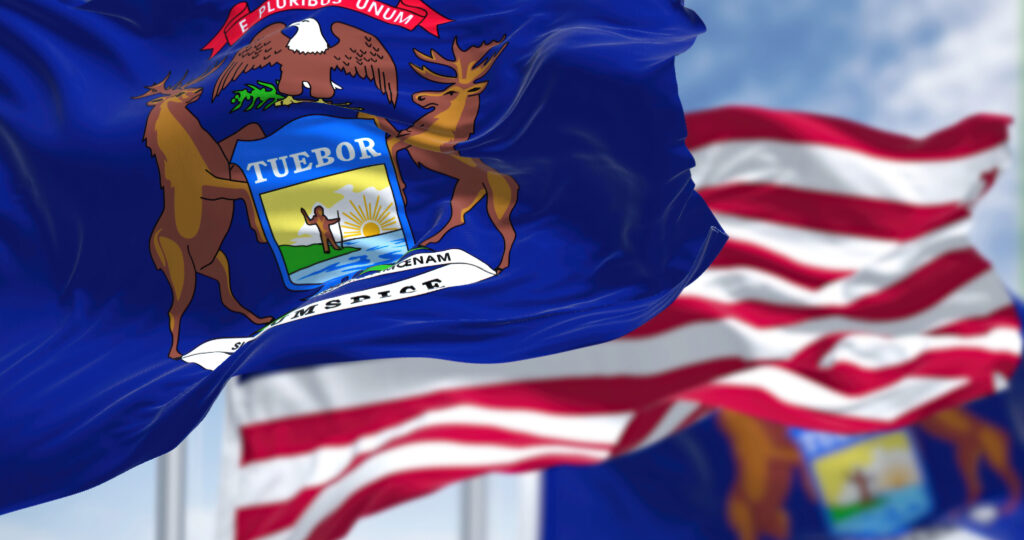It’s well-known what the stars and stripes stand for on the American flag, also known as Old Glory. But did you know that each of the 50 state flags has its own meaning and symbolism, unique to its region and history?
For example, Virginia’s flag represents the defeat of Britain at the hands of Virginia during the Revolutionary War. The flag of Massachusetts depicts the country’s hard-won liberty and freedom from the British monarchy.
But what about the flag of Michigan? Does the dark blue background have significance? What do the elk and the moose represent? Let’s find out as we explore the rich history and meaning behind Michigan’s state flag.
The Founding of Michigan
The land of Michigan is uniquely divided into two peninsulas, named the Upper and Lower Peninsulas. Before European settlers arrived in America, the land was the home of around 15,000 Native Americans. Most tribes settled along the shorelines of the Great Lakes and river valleys. Four of the Great Lakes frame Michigan: Superior, Michigan, Erie, and Huron.
The Treaty of Paris in 1783 ended the Revolutionary War. It created a boundary for the United States that included the territory of Michigan. But it wasn’t until 13 years later that the British gave up their control of the land. The British wanted control of the region because of the booming fur trade and the strategic location. The Union admitted Michigan as the 26th state in 1837. This was a delay due to a conflict with Ohio, known as the Toledo War. Now, this war wasn’t an actual war. There were no deaths and only one minor injury. The Toledo War was a border dispute between the state of Ohio and the territory of Michigan. And it was all over a strip of land known as Toledo.
To become a state, Michigan had to give up the Toledo Strip to Ohio. The state gained the western Upper Peninsula and statehood in the bargain. This concession turned out to be a win-win situation for the citizens of Michigan, as the region is rich in natural resources such as lumber and copper. No other state in the United States is made up of two peninsulas.

The current flag of Michigan represents an elk, moose, and a bald eagle. Each animal represents a piece of Michigan and United States symbolism.
©iStock.com/rarrarorro
History of the Flag of Michigan
Michigan’s current flag, adopted in 1911, is the third official flag for the state. Michigan’s first flag was flown in 1837, the same year Michigan gained its statehood. The original flag had two sides. On one side was the state seal, a soldier, and a lady. The reverse side bore the image of Steven T. Mason, Michigan’s first governor.
In 1865, a second flag was adopted, recommended by Adjutant-General John Robertson. It was followed with approval by Governor Crapowhich. This flag portrayed the state coat of arms against a blue background on one part of the flag, and the coat of arms of the United States on the other. Finally, Michigan’s current and third flag was adopted in 1911. Today’s flag pictures the Michigan coat of arms against a field of dark blue.
Michigan nearly adopted a new fourth flag in 2016 when a bill was introduced to the Michigan state legislature proposing to hold a public design contest for a new state flag. However, the bill was unsuccessful, and the flag from 1911 still hangs at the state Capitol today, just below the flag of the United States.
Symbolism and Meaning
More than just a piece of cloth, flags are powerful symbols representing a people’s ideals, identity, and character. Michigan’s flag displays the state’s coat of arms on a dark blue field on both sides.
Many state flags illustrate their coat of arms, but Michigan’s flag has only its coat of arms against a dark blue background. Michigan adopted this shade as its blue military colors in 1865 and used it on the flag in 1911.

The deep blue background color of the Michigan state flag is representative of the color chosen for its military in 1865.
©iStock.com/Oleksii Liskonih
History of Michigan’s Coat of Arms
Michigan has kept its current coat of arms since 1835. It hasn’t changed much over the years, with only a few minor design changes. There have been no changes since 1911.
The coat of arms comes from the Michigan state seal and includes three Latin mottoes:
- “E pluribus unum”
- “Tuebor”
- “Si quaeris peninsulam amoenam circumspice”
“E pluribus unum” translates to “One out of many,” meaning the United States is one country formed by many states. “Tuebor” means, “I will defend,” which refers to Michigan’s location as a frontier state in the 1800s. And finally, “Si quaeris peninsulam amoenam circumspice” translates to “If you seek a pleasant peninsula, look about you.”
An elk and moose (symbols of Michigan) support the shield on each side, while the bald eagle, the national bird of the United States, flies above them. The eagle is holding 13 olive branches and three arrows. The olive branches are a well-known symbol of peace, while the number 13 represents the first 13 states. The arrows held in the claw of the eagle show that the people of Michigan are ready to defend its principles. In the center of the design stands a man holding a rifle in one hand and waving his other. He represents both peace and the ability to protect one’s rights. The man stands on a green peninsula with a yellow sun setting over blue waters behind him.
The photo featured at the top of this post is © iStock.com/rarrarorro
Thank you for reading! Have some feedback for us? Contact the AZ Animals editorial team.







